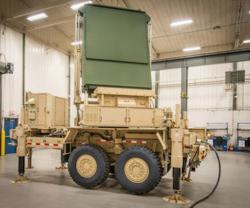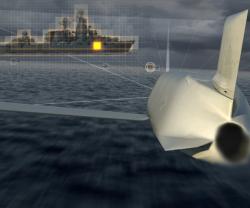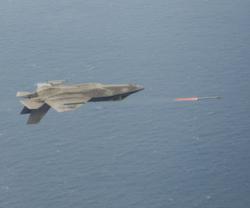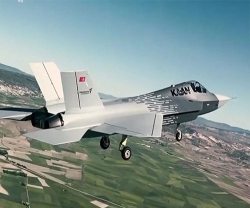Aegis BMD Uses Satellite Tracking Information for 1st Time
14.02.2013 North America
Lockheed Martin's second-generation Aegis Ballistic Missile Defense (BMD) system achieved its first intercept using tracking information from the space tracking and surveillance system demonstration satellites during a Missile Defense Agency (MDA) test.
The system successfully launched and guided a Standard Missile-3 Block IA guided missile to engage a medium range unitary ballistic missile target using remote tracking information from the satellites that was integrated through the Command and Control, Battle Management, and Communications (C2BMC) system.
U.S. Navy sailors aboard USS Lake Erie (CG-70) received tracking information from space tracking and surveillance satellites and launched the missile before the shipboard SPY-1 radar detected the target. The Aegis BMD Weapon System then guided the missile using tracking information from the space-based assets until the target was detected and tracked by the SPY-1 radar. The shipboard radar transmitted guidance commands to the SM-3 guided missile that intercepted the target.
“Aegis has achieved many firsts, but using accurate tracking information from a satellite to flexibly enable expanded battlespace and the capabilities of the sea-based Aegis BMD system may prove to be one of the program's most significant milestones,” said Nick Bucci, Director of BMD development programs for Lockheed Martin's Mission Systems and Training business.
“For a long time, many have believed the best path forward for missile defense is an architecture that combines flexible sea-based defenses with persistent space-based capabilities. This test proves that technology and that architecture can be a reality,” he added.
The test marks the ninth time in three years that the USS Lake Erie and its crew successfully performed at-sea operations against cruise and ballistic missile targets using the second-generation Aegis BMD system. Recently, it received faster, more powerful commercial-off-the-shelf signal processing equipment and updates to its weapon system computer programs.
Aegis BMD's upgraded signal processor enables the Navy to defeat more sophisticated ballistic missile threats using improved target identification capabilities. It includes an open architecture BMD computing suite that improves overall system capabilities and enables future insertion of more off-the-shelf products, third-party components and turn-key solutions.
The MDA and Navy are jointly developing Aegis BMD as part of the United States' Ballistic Missile Defense System. Currently, 26 U.S. Aegis BMD-equipped warships have the certified capability to engage ballistic missiles and perform long-range surveillance and tracking missions. That number is expected to increase to 32 by 2014.
The system successfully launched and guided a Standard Missile-3 Block IA guided missile to engage a medium range unitary ballistic missile target using remote tracking information from the satellites that was integrated through the Command and Control, Battle Management, and Communications (C2BMC) system.
U.S. Navy sailors aboard USS Lake Erie (CG-70) received tracking information from space tracking and surveillance satellites and launched the missile before the shipboard SPY-1 radar detected the target. The Aegis BMD Weapon System then guided the missile using tracking information from the space-based assets until the target was detected and tracked by the SPY-1 radar. The shipboard radar transmitted guidance commands to the SM-3 guided missile that intercepted the target.
“Aegis has achieved many firsts, but using accurate tracking information from a satellite to flexibly enable expanded battlespace and the capabilities of the sea-based Aegis BMD system may prove to be one of the program's most significant milestones,” said Nick Bucci, Director of BMD development programs for Lockheed Martin's Mission Systems and Training business.
“For a long time, many have believed the best path forward for missile defense is an architecture that combines flexible sea-based defenses with persistent space-based capabilities. This test proves that technology and that architecture can be a reality,” he added.
The test marks the ninth time in three years that the USS Lake Erie and its crew successfully performed at-sea operations against cruise and ballistic missile targets using the second-generation Aegis BMD system. Recently, it received faster, more powerful commercial-off-the-shelf signal processing equipment and updates to its weapon system computer programs.
Aegis BMD's upgraded signal processor enables the Navy to defeat more sophisticated ballistic missile threats using improved target identification capabilities. It includes an open architecture BMD computing suite that improves overall system capabilities and enables future insertion of more off-the-shelf products, third-party components and turn-key solutions.
The MDA and Navy are jointly developing Aegis BMD as part of the United States' Ballistic Missile Defense System. Currently, 26 U.S. Aegis BMD-equipped warships have the certified capability to engage ballistic missiles and perform long-range surveillance and tracking missions. That number is expected to increase to 32 by 2014.
Previous PostRaytheon’s SM-3 Engages Target with Remote Sensor
Latest news
Latest events
DSEI 2025
09 - 12 Sep 2025Excel, London - United KingdomIntersec Saudi Arabia
29 Sep - 01 Oct 2025Riyadh International Exhibition & Convention Centre - Saudi ArabiaDubai International Air Chiefs’ Conference (DIACC 2025)
16 Nov 2025Atlantis, The Palm Dubai - United Arab EmiratesDubai Airshow
17 - 21 Nov 2025Dubai World Central (DWC) - United Arab Emirates





















